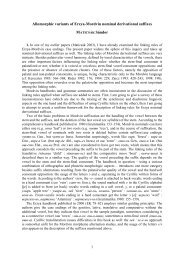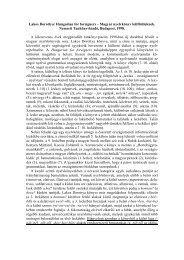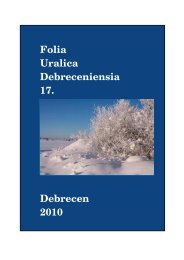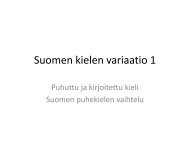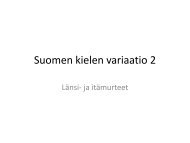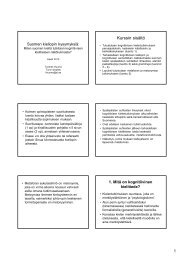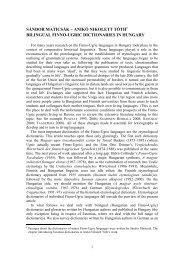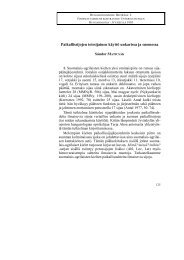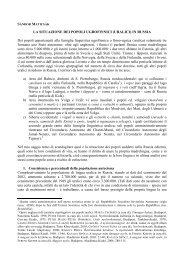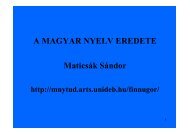folia uralica debreceniensia 19. - Finnugor Nyelvtudományi Tanszék
folia uralica debreceniensia 19. - Finnugor Nyelvtudományi Tanszék
folia uralica debreceniensia 19. - Finnugor Nyelvtudományi Tanszék
Create successful ePaper yourself
Turn your PDF publications into a flip-book with our unique Google optimized e-Paper software.
ISMERTETÉSEK – REZENSIONEN – REVIEWS – KATSAUKSIA – РЕЦЕНЗИИ<br />
Isohookana-Asunmaa genuinely believes that the Csángós would best be<br />
recognized and protected as a distinct Finno-Ugric culture and language,<br />
such as the Meän kieli speakers in the north. However, she manages to<br />
mention just a handful of Csángó intellectuals, most of whom no longer live<br />
in Moldavia, and few of them consider the Csángó as a distinct culture.<br />
Rather, it is seen as an attachment to the Hungarian national culture. Further,<br />
as she notes, most practical support for the Csángós has come from Hungary<br />
or from the Hungarians in Transylvania. Hungarians in general are motivated<br />
to help the Hungarians in Moldavia, not a separate Finno-Ugric culture and<br />
language. That is, a Csángó revival is not in sight.<br />
The European Council handles the issue as purely a human rights question.<br />
The arguments for and against of the Hungarian or Romanian origin or<br />
national feeling among the Csángós is not an issue for the European Council.<br />
Isohookana-Asunmaa sees the Csángós as Finno-Ugric people or nation. In<br />
her opinion it should be treated and protected in the same way as any other<br />
small Finno-Ugric linguistic minority.<br />
The volume under review is not a report of Finno-Ugristic research, neither<br />
does it aim at an academic presentation of the Csángós. However, it lucidly<br />
documents and explains the motivation, background, political reasoning<br />
and interpretations of cultural and linguistic issues behind Tytti Isohookana-<br />
Asunmaa’s work. It also documents her close relationship with the Csángós.<br />
Not everybody will agree with her interpretations, however, I guess a<br />
consensus can be reached that her intentions and political activity are of<br />
exemplary nature and that her persisting devotion to help the Csángós admirably<br />
extraordinary. A Hungarian translation of the book is in preparation.<br />
PETTERI LAIHONEN<br />
Hadobás Sándor (szerk.): Halász Ignác három lappföldi útja<br />
<strong>Finnugor</strong> Tudománytörténeti Füzetek 1.<br />
Izsó Miklós Művelődési Ház és Könyvtár, Izsófalva 1997. 132. l.<br />
A <strong>Finnugor</strong> Tudománytörténeti Füzetek c. sorozat nyitókötete a magyarországi<br />
lappológia egyik kiemelkedő alakjának, Halász Ignácnak három lappföldi<br />
úti beszámolóját tartalmazza. Az eredeti szövegek (Budapesti Szemle<br />
41, 51, 70; Földrajzi Közlemények 18) együvé szerkesztése Hadobás Sándornak<br />
köszönhető.<br />
225



